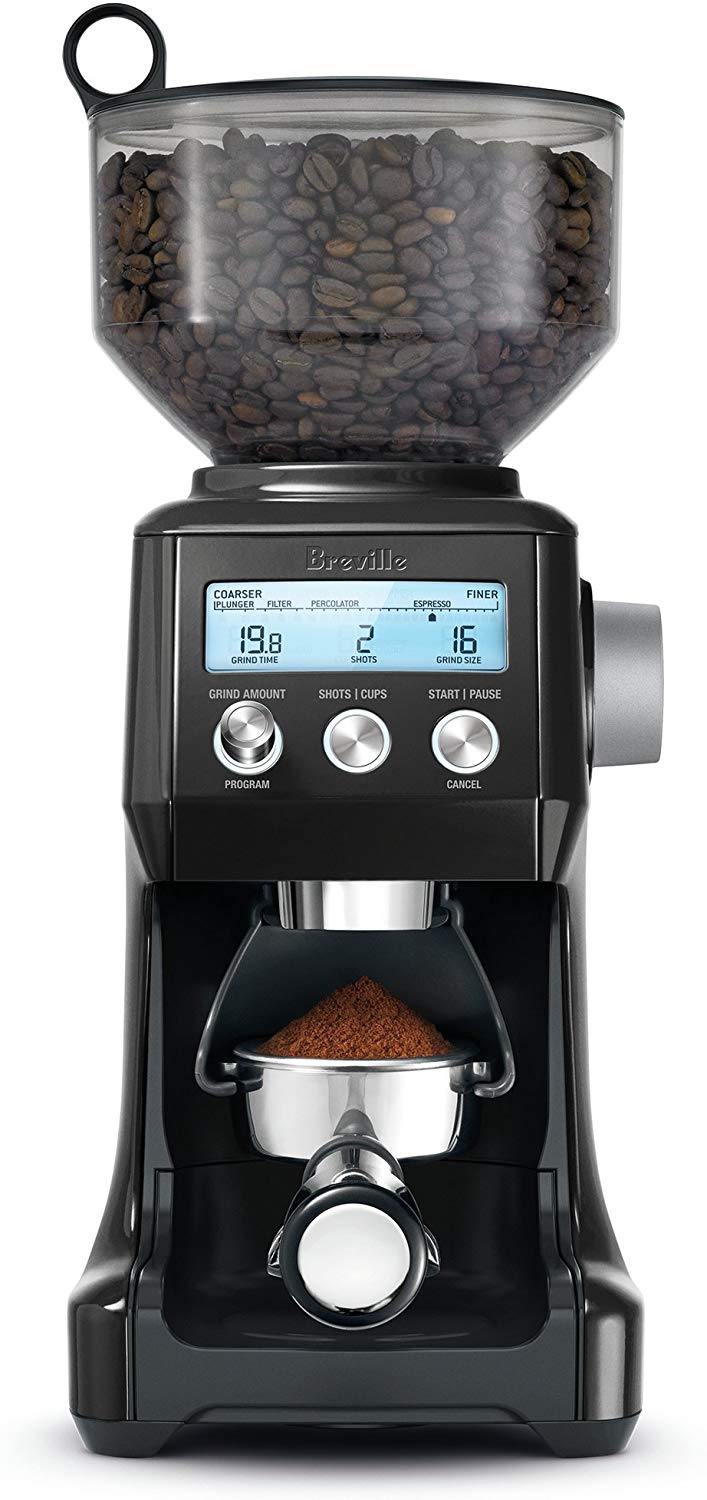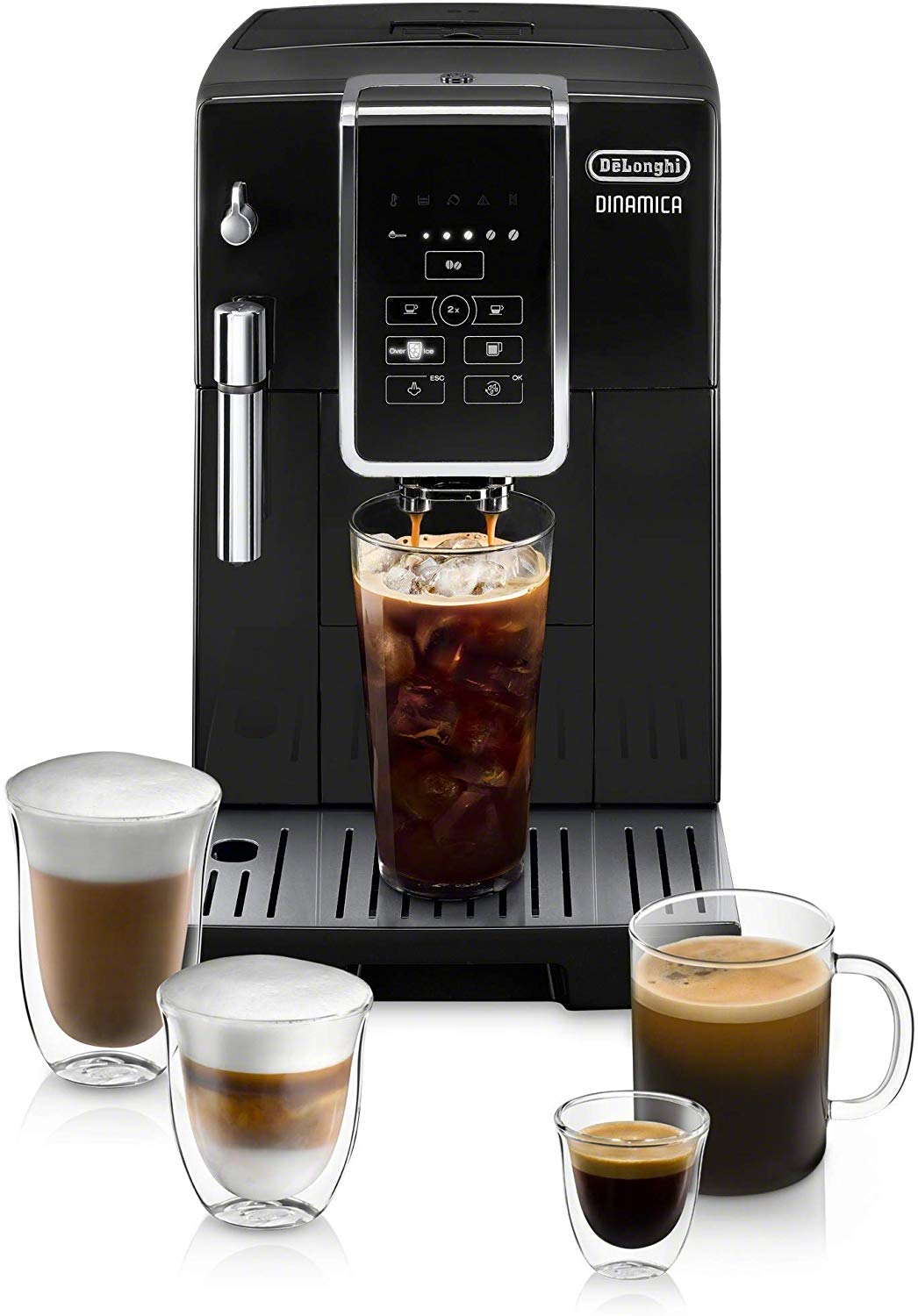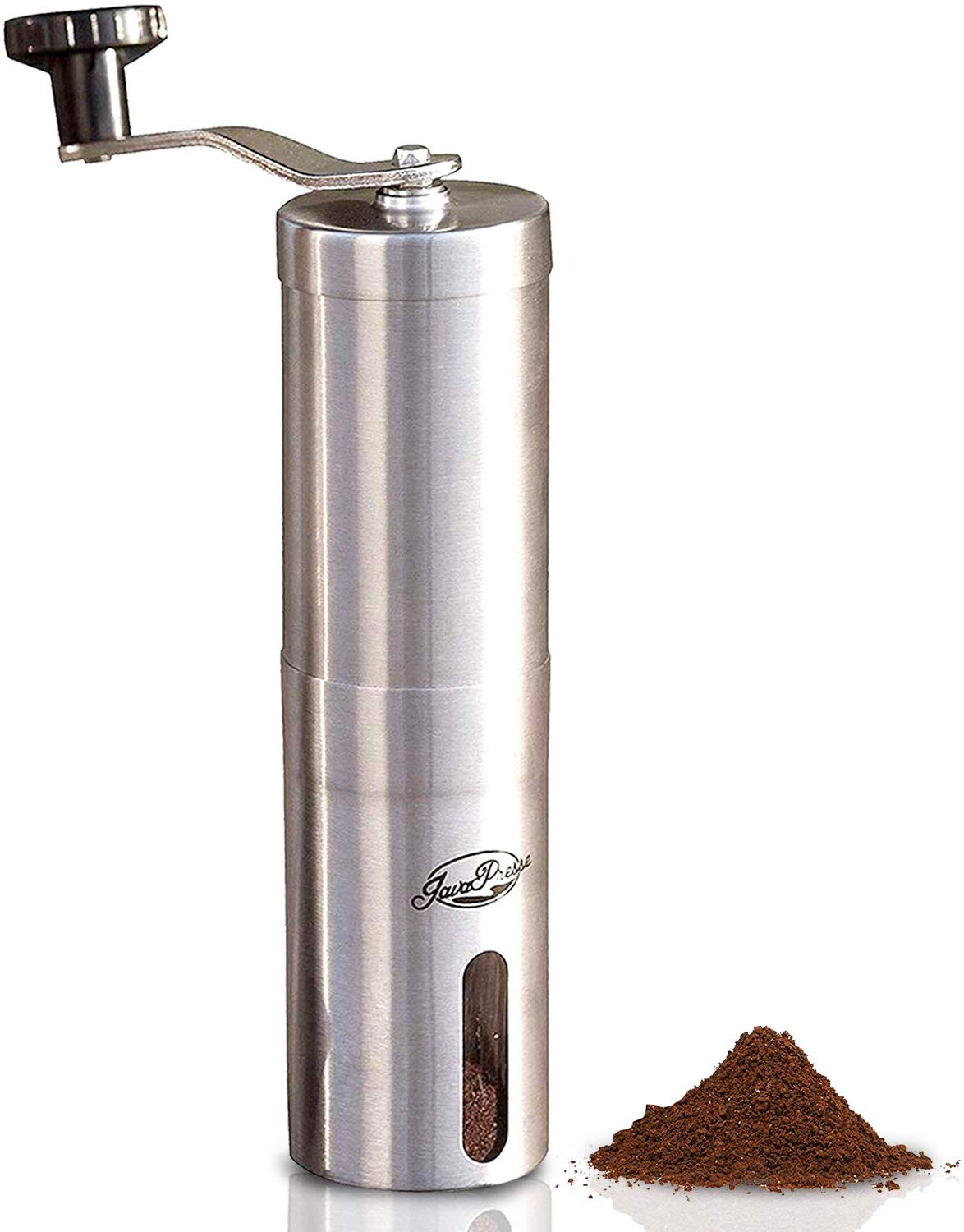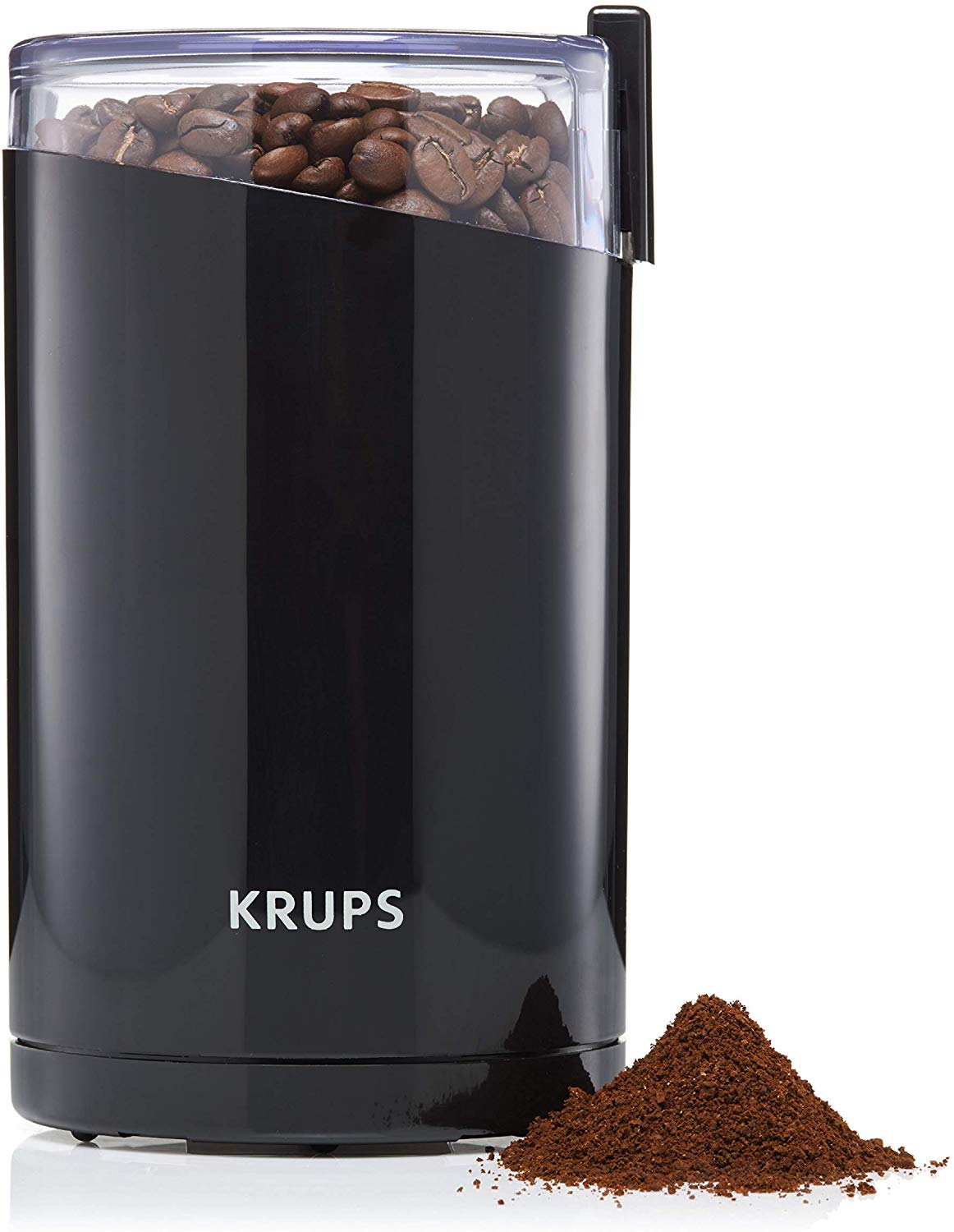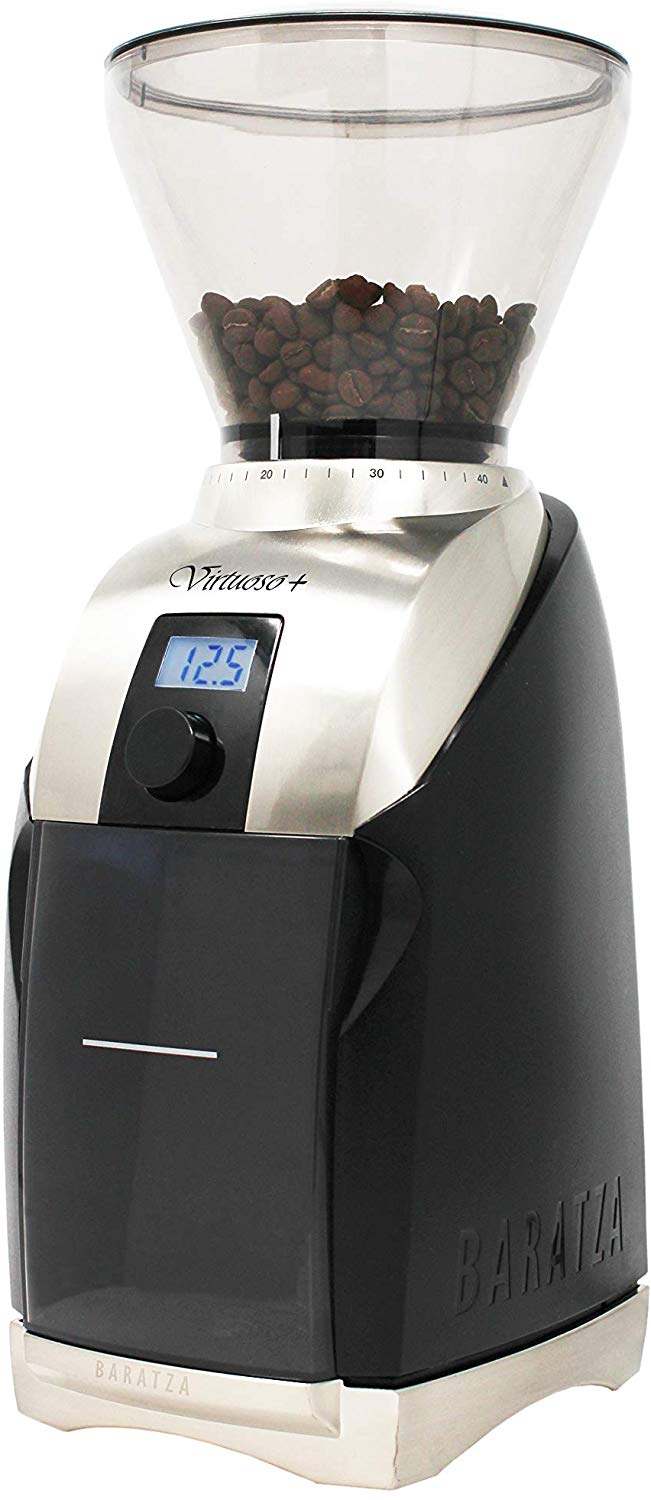Best Budget Espresso Grinder
The quality of espresso depends on many variables – the quality of the coffee beans, how it has been grown, picked up, how it has been ground, and how it has been brewed.
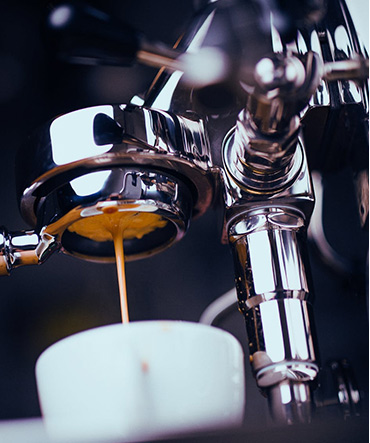
Today, we’d like to focus on the grinding aspect of a great cup of espresso. Of course you'll need some great coffee beans, but the coffee grinder and its settings are equally important!
If you want to make excellent espresso, then grinding your own coffee beans at home is optimal because you have more control over how the coffee is ground and how long it is stored thereafter. However, picking a good grinder can be challenging because there is a huge variety on the market. Perhaps too many.
Well, if you’ve found yourself at a loss when shopping for the highest rated espresso grinder, then let us offer 5 great options to you. Our reviews are below!
Check out the 5 Best Espresso Grinders you should buy in 2022
1. Breville Smart Grinder Pro
With 60 grind settings, the Breville Smart Grinder Pro burr grinder is arguably the most versatile grinder on our list. Thanks to the huge number of grind settings, you should be able to grind coffee to the right fineness for your espresso preference.
What’s also interesting about the Smart Grinder Pro is that it allows you to adjust the grinding time in 0.2-second increments. With such fine adjustments, you could expect it to deliver exactly the amount of coffee you want.
Besides, thanks to the large 16-ounce bean cup, the Smart Grinder Pro model will be a capable option whether you need just one coffee cup for yourself or several cups for your guests at home.
You may also select the number of cups to be ground, and the built-in LCD display will show the time, fineness, and grind settings you’ve selected.
For increased convenience, the Smart Grinder Pro allows you to grind coffee directly into the provided portafilter, your own portafilter, or any other container of your choice.
Well, the Smart Grinder Pro model seems like a great grinder, but what about its cons? It has a few.
A common complaint about this product is the delicate plastic impeller below the burrs which seems to wear out within a year of purchase, depending on use. Newer units of these machines may not have this issue, but even if you run into it, you may send it to Breville for repair or try to find a replacement impeller yourself. This has got to be one of the best coffee grinders on the market today with amazing reviews, so we highly recommend it for your home.
Pros:
- 60 grind settings.
- Grinds with consistent quality.
- Precise electronic timer for coffee amount adjustment.
- Can grind directly into a portafilter.
- Large 16-ounce bean cup.
Cons:
- Delicate plastic impeller.
2. JavaPresse Adjustable Manual Coffee Grinder
If you are into manual coffee grinding, then JavaPresse’s burr grinder may be an interesting option for you. For many people, coffee preparation is no less important than drinking coffee, and manual ones are exactly for such users.
As a manual grinder, the JavaPresse grinder has plenty of benefits over its electric counterparts – it is nearly noiseless, has no motors to maintain, and requires no electricity. As a downside, you have to do everything manually with this grinder, so grinding coffee for four could take half an hour.
In spite of this, the JavaPresse manual grinder is a solid choice for espresso. Most importantly, it has 18 fineness settings which should allow for good espresso, though maybe not as good as you can achieve with the Breville grinder.
What may matter to you as well is that it produces very negligible amounts of heat, so if you are worried about heat spoiling your coffee beans or altering the taste of the espresso, the JavaPresse coffee grinder could again be a good option.
In terms of durability, this manual grinder seems to be decent. It has stainless steel blades that should serve you a lifetime, but there are some plastic parts here and there that may wear out sooner or later.
Interestingly, JavaPresse provides a code with this coffee grinder, allowing you to redeem a free bag of coffee ($21.99 value as claimed by JavaPresse). Though you’ll probably be using your own coffee with this thing, the offered coffee may be worth a shot (pun intended).
Pros:
- Very inexpensive.
- 18 fineness settings.
- Very quiet and cool.
- No motors or batteries to maintain.
- Comes with a code to redeem a free bag of coffee.
Cons:
- Very slow grinding.
3. De’Longhi Dinamica Automatic Coffee & Espresso Machine W/ Grinder
If you want a coffee grinder AND an espresso machine, then the Dinamica coffee & espresso machine by De’Longhi could be the right option for you. This thing is a pretty high-end grinder and costs quite a lot, but it should be a fine choice for espresso connoisseurs.
For grinding, the DInamica features a burr grinder with 13 grind settings. Although this certainly won’t allow as much flexibility as the Breville grinder, 13 grind settings should be enough for a great cup of espresso.
Being a grinder & espresso machine, Dinamica delivers coffee from the coffee beans right to your cup. This is what the “automatic” capability of this one is about. With its easy to use capabilities it is undoubtedly one of the top coffee makers on the market today.
In terms of coffee-making, Dinamica is great. First off, it allows very flexible control over the cup’s size, amount of coffee, and temperature. Making specialty coffees should not be a problem with the Dinamica coffee maker.
Then, what’s very nice about this product is that it is claimed to heat up in less than 40 seconds.
If you like to froth your espresso, then you’ll also be glad to hear that Dinamica comes with an integrated manual frother. De’Longhi also boasts that this is capable of delivering iced coffee that is “never watered down”.
At this price point, you would expect Dinamica to be flawless, but it has a few downsides, unfortunately. They are mostly connected with intuitiveness.
The thing is that to successfully navigate the menu of this thing, you’ll need to use the manual – the onboard software is less informative than it should have been. Moreover, the manual itself is subpar, though you may download a superior online variant.
The initial setup of the Dinamica machine may thus be a little rough, but once you get the hang of it, you could expect to get the finest cup of espresso you’ve ever had.
Pros:
- Grinder, coffee, and espresso machine all in one.
- 13 grinding settings.
- Touchscreen control panel.
- Allows for cup programming.
Cons:
- Very expensive.
- Not the most intuitive controls.
- Inadequate instruction manual.
4. KRUPS F203 Coffee & Espresso Grinder
If you aren’t too demanding when it comes to espresso, then have a look at the F203 blade grinder by the KRUPS F203 model. This grinder is far less capable than the electric grinders overviewed so far, but it’s much, much cheaper as well.
The F203 will do its job fine, though it will not deliver as consistent grind as a burr grinder. Aside from that, this grinder doesn’t have fineness setting adjustment. The only way for you to adjust the fineness in this grinder is to keep it on for longer so that it achieves a finer grind.
On the other hand, the simplicity of this coffee grinder may be very attractive to you, because you just need to pour in some coffee beans, put the lid on, turn the thing on, and wait until it achieves the desired fineness.
The F203 also allows you to prepare a good amount of coffee in one go – with its capacity of 3 ounces, it is claimed to deliver 12 cups of coffee in one session, though this will depend on your preferred cup size.
A notable feature in the F203 is the lid-activated safety switch – unless the lid is on, it will not work. This should eliminate the risk of any accidents.
In the end, if you are easy to satisfy when it comes to coffee and espresso, then this coffee grinder may be the right one for your espresso needs.
Pros:
- Inexpensive.
- Lid-activated safety switch.
- Grinds coffee quickly.
Cons:
- Little fineness adjustability.
- Not the most consistent grind.
5. Baratza Virtuoso+ Coffee Grinder
The Baratza Virtuoso+ conical grinder is an excellent value for the money – it’s durable, allows for flexible grind adjustment, and grinds coffee with consistent quality.
In terms of adjustment, Virtuoso+ has 40 grind settings to choose from – not as many as in the Breville Smart Grinder Pro, but it should be enough for most espresso needs. Aside from that, it allows for grinding time adjustment down to 1/10 of a second, and you may set the grinding time as long as 40 seconds.
The capacity of Virtuoso+ is solid as well – it has an 8-ounce bean cup that should allow you to grind coffee for a few dozen cups.
What Baratza also boasts about is durability – they claim that they have designed this coffee grinder to last. Well, Virtuoso+ seems not to have weaknesses like the impeller in Breville Smart Grinder Pro, but only time will show whether this machine lives up to the promise.
Notably, the motor in this coffee grinder has a gearbox that allows the machine to grind coffee beans without clogging. Aside from that, since the steel conical burrs rotate at a slower speed, this machine is less noisy and produces less heat than a traditional burr grinder.
The price is also pretty good on this model as well.
Pros:
- Durable.
- Quiet and cool operation.
- Grinds consistently.
- 40 grind settings.
- Very precise electronic timer.
- 8-ounce bean cup.
Why Having A Grinder Could Make Your Espresso Even Better
Like it is pretty much with any piece of coffee-making equipment, having your own grinder for espresso implies better control over the bean preparation process.
Ground coffee loses its flavor properties within a few days after grinding. When you are grinding your own coffee, it’s very easy for you to control how long they are being stored.
On the other hand, when you are dealing with store-bought grounds at home, can you really tell how long the coffee has been stored in the warehouse? There certainly are coffee sellers that only roast and grind their coffee on demand, but how can you be sure that the coffee beans in your local shop are fresh?
If this is a big concern for you, then it will probably be worth it for you to buy one of the high quality machines to grind your espresso beans with at home. Check out our reviews on this page to find the best one for you!
Which Coffee Grinder Would Be The Best For Espresso?
Although there is no such thing as a grinder designed specifically for espresso, some coffee grinders will produce better ground coffee for espresso than others.
With this in mind, there are two things that a great espresso grinder should have – the capability to produce a fine grind, and low heat output.
A great espresso grinder will produce a fine grind
If you remember, espresso is made by forcing boiling water through finely-ground beans. The key thing here is that the coffee beans need to be fine – otherwise, the water will not be able to go through them.
What this means is that only some coffee grinders will work well for espresso at home if they can produce a fine grind. The vast majority of coffee grinders on the market do allow you to achieve a sufficiently ground coffee for espresso. But, as mentioned above, some will do better than others.
The top espresso grinders will not heat up too much
Heat is undesirable for any coffee, not just espresso, but it’s worth talking about it here as well.
Some of the heat produced by the motor assembly will be transferred to the espresso. In fact, the longer you grind, the more heat will be produced, and, obviously, the hotter your coffee beans will get.
It’s generally considered that excessive heat speeds up oxidation and can quickly lead to spoilage of coffee. So you may want to use your ground coffee immediately.
Secondly, heat may negatively affect the taste of your espresso. With that said, the changes usually aren’t that noticeable, unless it gets really hot. Many cheap coffee grinders are not built for long term use and heat up easily.
And finally, even if the taste of your espresso is perfectly fine, then your drink may be warmer than you expect.
Things To Look For When Buying A Coffee Grinder For Espresso
There are plenty of things to pay attention to when shopping for a home coffee grinder.
Firstly, you have features that affect the quality of the espresso specifically. Then, then also are more generic things that matter in coffee grinders no matter what kind of coffee you are intending to make and whether or not it is easy to use.
Below, we’ll talk about the key features that matter in an at home coffee grinder for espresso. We’ll talk about features that affect espresso quality directly, and we’ll also cover the things that generally make a coffee grinder good or not.
Types of coffee grinders
How exactly a coffee grinder grinds coffee may hugely affect the quality of the grind and the quality of your espresso. With this in mind, let’s talk about four types of grinding mechanisms used in the best coffee grinders. More specifically, we’ll talk about the mechanisms used in electric coffee grinders.
Blade grinders
If you are on a tight budget, then you may have to buy a blade grinder – it’s the most inexpensive electric machine out there.
The blades rely on a spinning blade to grind coffee. The longer the blade spins, the finer the coffee will be.
If you haven’t gotten used to your specific blade grinder, then it can be difficult to achieve a precise grind size. You just can’t know how fine the beans will get after, say, 20 seconds of grinding. You’ll need to do some trial and error to find out an optimal grinding time.
Although the blade is positioned low to catch as many beans as possible, it may still miss some. As a result, the grind quality isn’t always consistent.
Aside from that, blade grinders tend to produce a lot of noise, and the heat generated by the blades may affect the taste of the coffee.
But for less demanding espresso drinkers, a good blade option may do just well enough.
Burr grinders
A burr grinder is perhaps the most common grinder type on the market. This type of coffee grinder is also called a flat burr grinder.
A burr grinder uses two flat burrs to grind coffee – one burr is stationary, while the other is rotated by the motor. Coffee beans go in between the two burrs, being crushed in the process. The fineness of the grind depends on how close the burrs are to each other, which can be adjusted in the burr grinder.
They tend to deliver fairly consistent grind quality, though they do occasionally let through larger fragments of beans as well. But given that burr grinders tend not to be very expensive, they deliver great value for the money.
Conical burr grinders
Conical burr grinders are a subtype of the burr grinder. Thanks to a few features, conical burr grinders are generally considered to deliver the most consistent grind, but they also tend to be pretty expensive.
A conical burr grinder tends to rotate the burrs slower than regular grinders, which allows for less noise and lower heat production. The slower speed is possible thanks to the shape of the burrs in conical grinders, as well as is a consequence of motor design.
As a result, conical burrs generally work longer, impact the taste of coffee the least, and produce a very consistent grind. Thanks to the latter, a conical burr grinder is optimal for espresso-making, though a flat burr grinder can deliver pretty comparable results.
Manual vs electric grinders
We’ve had both electric and manual options on our list, so it’s worth talking about their differences as well.
When it comes to espresso, there are two things that matter when trying to choose between a manual or electric grinder:
- With an electric grinder, you can make espresso much quicker.
- With a manual grinder, you won’t be exposing the beans to any heat. This also applies to some electric models, but more on that later.
For most of us, the convenience of electric coffee grinders is a huge benefit. You can very quickly grind enough coffee for several cups of espresso, and you’ll also see some noticeable time savings even if making one cup.
Manual coffee grinders have the edge when it comes to heat production. Aside from that, some of us will find the process of grinding beans enjoyable, and if you are one of them, then you might want to pick a manual grinder for home use.
Manual grinders also tend to be very inexpensive, so they are excellent for those on a tighter budget.
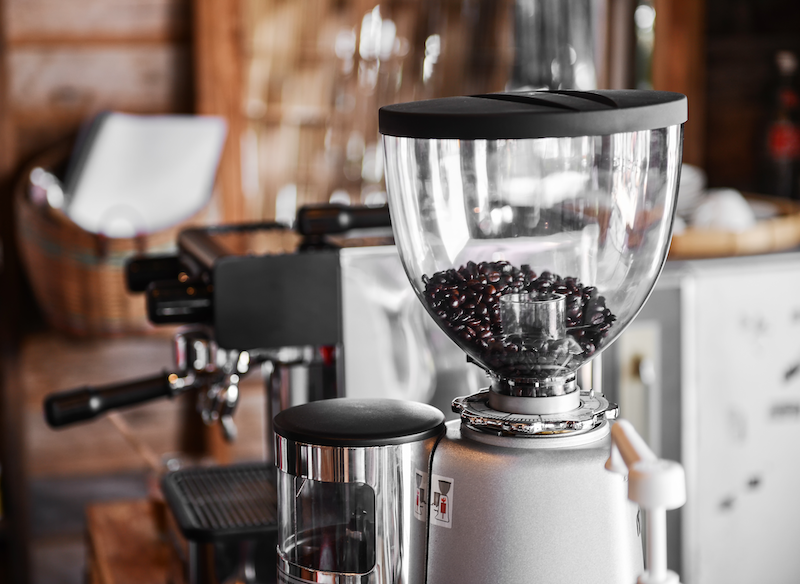
High-speed vs low-speed grinders
There are both high-speed and low-speed options. How high the RPM of the motor of your grinder is has huge implications on the quality of the grind and the quality of the espresso.
Operating at thousands of RPM, high-speed ones tend to produce more heat, which might negatively impact the taste of espresso. With that said, high-speed grinders usually grind coffee very consistently, and they also typically offer you more control over the grind size.
On the other hand, low-speed grinders typically run under 1,000 RPM and offer a few important benefits:
- They produce no static charge. If sufficiently strong, static charge can cause the coffee to jump out of the ground container.
- They produce less heat, and you already know what the benefits of low heat are.
- They typically are much quieter than their high-speed counterparts.
- Finally, the motor is less prone to clogging when dealing with very fine grinding settings.
Keep in mind that conical burr grinders usually have low-speed motors, while other types have high-speed motors.
Low-speed grinders can achieve low RPM in two ways:
- Gear reduction. The motor operates at high RPM, but it is connected to a few gears that make the rotation of the burrs slower. Low-speed grinders with gear reduction have good grinding performance, but they tend to be relatively noisy, as well as may create some heat, though it will not be produced by the burrs themselves and will be away from the beans.
- Direct-drive. In direct-drive low-speed grinders, the motor has low RPM and is connected to the burrs directly. What such a design allows for is quiet operation along with minimal heat and static.
By the way, high-speed motors usually use direct-drive motors. If you see an option with a direct-drive motor, don’t automatically assume that it is a low-speed grinder.
As you might have already guessed, the low-speed ones are the costlier espresso machines out of the two types.
For most people, a high-speed coffee grinder will suffice – though high-speed ones may not allow for as exceptional espresso, they can produce pretty spectacular coffee, allowing for great espresso.
But if you are a coffee connoisseur and want the best espresso, then go for a low-speed grinder. Once you try espresso made from coffee ground with a low-speed grinder, there will be no way back for you.
Fineness settings
Most options will allow for adequate fineness for espresso. However, it might be a good idea to get a coffee grinder that has more grind sizes to choose from.
You don’t need to get one that has 100 grind sizes – merely 10 sizes may be just enough for your needs. With that said, the more settings you have, the more flexibility you will be able to enjoy while making your drink.
Aside from the grind size, try to find out how consistent the coffee grinders are, because some can grind beans very finely, but they don’t hold up well to long term usage. Above, we’ve discussed the main things that impact the consistency of the grind, so do keep them in mind.
Outfeed container options
Most grinding options outfeed the grounds to an integrated container. Such a method will probably be convenient enough for most people.
However, some of the best coffee grinders allow you to hook up a portafilter and outfeed the coffee right into it. This certainly isn’t a must-have feature, but it will allow you to save time while making coffee since you’ll be able to just take the portafilter with the coffee out and plug it into your espresso maker.
Chute size
Finally, consider the size of your coffee grinder’s infeed chute.
Unless you are going to grind huge amounts of coffee, then we think that pretty much any of these coffee grinders could work great for you. Otherwise, if you are looking to grind coffee for several cups, then look for a larger chute that will take the desired amount of coffee.
Be mindful that if you won’t be grinding a lot of coffee, there is no point in having a large chute. You sure can grind a few days’ worth of coffee, but this wouldn’t be reasonable since ground coffee spoils quickly.
Final Words: Thanks for reading!
It’s pretty difficult to pick the best coffee grinders for your needs – there are too many options out there. But if you follow our guidelines, you should be able to find the right option for your home relatively easily.
Our 5 picks should be a good place to start. Even if none of the reviewed options seem to be the optimal product for your espresso needs, then our buyer’s guide and product reviews should be able to help you understand all of the options better and thus spend your money on a good unit for your home.

